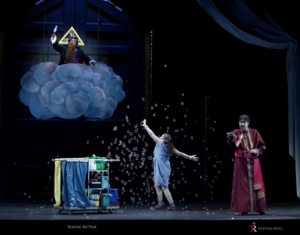
Teatro Real de Madrid 2021-22 Review: La Cenerentola
Aigul Akmetshina Leads Stefan Herheim’s Messy & Imaginative Production
By Mauricio Villa(Credit: Teatro de Madrid)
The Teatro Real de Madrid opened its 2021-22 season with Rossini’s opera buffa “La Cenerentola” based on the famous tale of “Cinderella.” This is Teatro Real’s second post-lockdown season and is still presenting the works with social distancing and obligatory masks for members of the choir and extras.
With “La Cenerentola” the Teatro was able to attract a diverse audience from opera lovers to opera beginners due to its amusing music and popular story. Without denying the musical value, the vocal writing is simpler than most of Rossini’s operas and therefore has been performed more frequently.
An Imaginative & Messy Production
The production, coming from Den Norske Opera in Oslo and Opera National Lyon was directed by Stefan Herheim. It was imaginative, colorful, comical, and amusing. During the overture, Angelina entered the stage with a uniform and equipment used by the cleaning crew of Teatro Real and added some jokes in Spanish. That was a clever way of making the production unique and close to Madrid’s audience rather than just a revival. The imaginative sets, designed by Herheim along with Daniel Unger contained multiple fireplaces in an impossibly comic perspective, which worked as book labels and as the interior of a poor household when changing positions and turning. There was tremendous creativity like the finale of the first act, as all of the soloists set their heads on trays at the table. The staging of the storm used the cleaning trolley as the prince’s carriage while the rest of the soloists controlled the theatrical effects, like fog, wind, or thunder.
But some of the excess creativity did not work so well. To begin with, Herheim wanted to tell too many different parallel stories. Don Magnifico and the chorus were dressed as Rossini, turning the whole opera into a dream from the perspective of the cleaning lady of an opera house. These multiple ideas turned the famous tale into a confusing mess. Secondly, there was constant action on the stage. There was so much dancing and movement that it lacked a climax and took away from the focus in important places like Ramiro and Angelina’s arias. But if the aim of the director was to entertain the audience, he succeeded, even if he sacrificed a concise point of view.
A Balanced Cast
Aigul Akmetshina played the role of Angelina to incredible results. The coloratura and fluidity in the score suited Akmetshina’s vocal line perfectly. She showed her potent low notes from the very beginning with a sonorous low A in the line “Via lasciatemi cantar.” She demonstrated nice voice control in the roulades, fast scales, and cadenzas that are constantly present in the score. But she was by far more comfortable in the middle and lower registers, which are present throughout the whole opera, except in Angelina’s final big aria “Nacqui alláffanno e al pianto.” During this aria, the mezzo-soprano had trouble with the two first scales rising to a B natural in “come un baleno rapido” resulting in pushed high notes sounding slightly flat. Nevertheless, the two high B naturals in the cabaletta’s final bridge were brilliant. She also proved her stamina and physical endurance in Herheim’s demanding staging.
The young Italian American tenor Michele Angelini portrayed the noble prince Don Ramiro. Angelini has one of the most promising lirico leggero voices as he has a sweet timbre, clean fast coloratura, and secure high notes. During the evening, his coloratura and diction were clean and clear, giving a sense of easiness in the role. He tends to open the sound above the passagio which does sound more natural but lacks projection in his top register. Angelini’s voice was at his high point during the aria “Si ritrovarla io giuro” as he held the final traditionally interpolated high C till the very last bar of the orchestra. That created an exciting climactic moment evening if it was a dubious musical choice.
The baritone Borja Quiza played Ramiro’s cavalier Dandini. A natural buffo singer, Quiza has a lyrical instrument with a brilliant metallic timbre and modest volume that suits Rossini’s buffo patter writing. His opening aria ”Come un’apene giorni d’aprile” sounded effortless and comical, even in the high tessitura. His flexibility was even more vivid in how he handled all the fast coloratura of the role in such a high tessitura. His acting was energetic making the character funny and believable at the same time.
The Italian baritone Nicola Alaimo sang the role of Don Magnifico. At first, his heavy, dark Verdi sound did not seem appropriate for a role that relies on syllabic singing. However, Alaimo controlled his voice and successfully accomplished the fast, spoken singing in the music, while, imprinting a serious dark quality. He also avoided the excessive vocal clichés traditionally used in this repertoire.
The young Italian bass Ricardo Fassi portrayed Alidoro with a velvety quality that shined in this Bel Canto role. He has a stunning ability to effortlessly sing long fiato lines that are required for this role. Fasi managed to give dignity to his character in Herheim’s staging as he went away from the usual clownish characterizations.
Rocío Perez and Carol García sang the supporting, but very important roles of Clorinda and Tisbe, the stepsisters. Their voices melded together perfectly. The duo’s interpretation was hilarious.
Incredible Conducting
The Italian conductor Ricardo Frizza was in charge of the Teatro Real orchestra. From his experience in the Bel Canto repertoire, here he made the simplistic orchestration become vibrant and alive. Rossini’s buffo operas are always filled with lively music and sometimes feel banal but under Frizza, the conductor kept tension in the famous Rossini Crescendo presented in the overture and first act finale. He respected the singer’s vocal lines by keeping tempi reasonable so they were comfortable with the coloratura which always requires specific tempi. It was never too slow or too fast. Frizza seems to breathe with the singers, and that’s very important in repertoire that relies on vocal pyrotechnics. The male section of the Chrous did an excellent job sounding powerful as they danced during most of its passages.
In conclusion, the excessive production, which was greatly appreciated by the audience, was held together by a talented cast of young singers who performed the piece with an adequate style and were committed to the physical staging. However, it was Riccardo Frizza who stood out the entire evening.


